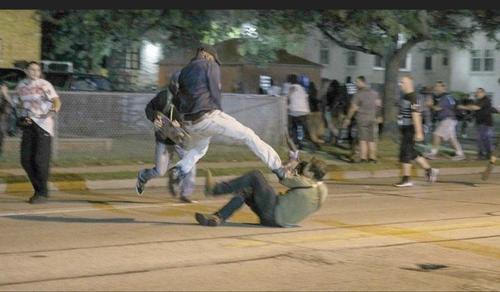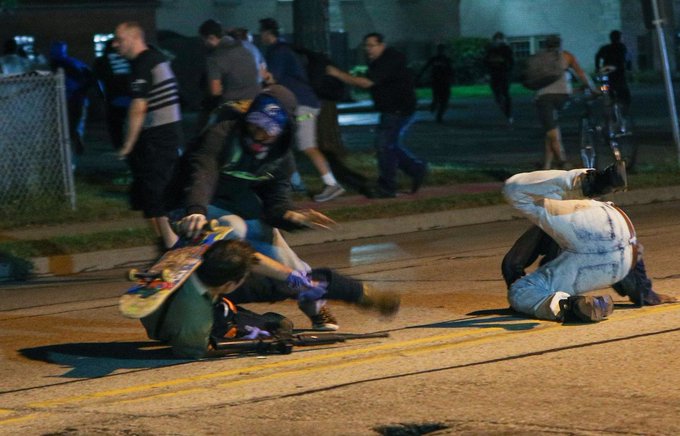by Revolver News
Six weeks ago, Revolver News published a blockbuster investigative report
on Ray Epps — a man who, more than any other individual, appears to be
the key unlocking the question of active federal involvement in the
so-called “Capitol Siege” of January 6th.
It is noteworthy that this Ray Epps breach occurs just one minute after Capitol Police began responding to reports of two “pipe bombs” located at DNC and GOP headquarters, respectively. Rather conveniently, the already-handicapped Capitol Police thus had still-fewer resources with which to respond to the barricade breach in question.
While the “pipe bombs” turned out to be a dud, the Ray Epps breach proved fateful. Today, the official stories told by the New York Times, the Wall Street Journal, and the US Justice Department all depict the apparent Ray Epps-orchestrated 12:50 p.m. initial breach of metal barricades as the “Big Bang” event of January 6.
In large part, this description is hardly an exaggeration. Indeed, it was the 12:50 p.m. breach of the Capitol grounds, in conjunction with a handful of suspicious individuals ripping down fencing and signage, that set in motion the conditions allowing for 1/6 to turn from a rally into a riot.
In this report, we will blow open this network of still-unindicted key operators who appear to have been at work either with or around Ray Epps during the initial Capitol grounds breach. You, dear reader, will be scandalized — though perhaps unsurprised — to learn that none of the actors covered in this report have received attention in the mainstream press, despite their active and indispensable roles in the events of 1/6.
As we explained in detail in our previous report, the FBI originally put Ray Epps’s face on its Capitol Violence “Most Wanted List” on January 8, 2021, just two days after 1/6. They offered a cash reward for information leading to his arrest. In fact, rank-and-file FBI agents initially deemed Epps’s role as an apparent riot organizer so important that they named him Suspect #16—one of the first 20 high-profile FBI targets in a database now packed with more than 500 suspects.Then, six months later on June 30, 2021, both Revolver News and The New York Times published inconvenient stories that encouraged a more aggressive interrogation of the “Ray Epps third rail,” leading reasonable people to wonder why this publicly identified man on the Most Wanted List still had no charges filed against him.
The FBI responded to these important media stories the very next day. But their response was to quietly purge all online Ray Epps files from their website, then switch to a posture of “What? Who? Ray Epps? Never heard of him.”
Agents of the FBI Field Office in Phoenix (where Epps lives) have gone so far as to explicitly deny knowledge that Ray Epps even exists. Instead of pursuing Epps, FBI agents have instead pursued journalists who had the temerity to ask Epps in person if he was a government operative. “I understand that, but I can’t say anything,” is all Epps would tell them.
Here’s a quick visual synopsis of this timeline:
Then, six months later on June 30, 2021, both Revolver News and The New York Times published inconvenient stories that encouraged a more aggressive interrogation of the “Ray Epps third rail,” leading reasonable people to wonder why this publicly identified man on the Most Wanted List still had no charges filed against him.
The FBI responded to these important media stories the very next day. But their response was to quietly purge all online Ray Epps files from their website, then switch to a posture of “What? Who? Ray Epps? Never heard of him.”
Agents of the FBI Field Office in Phoenix (where Epps lives) have gone so far as to explicitly deny knowledge that Ray Epps even exists. Instead of pursuing Epps, FBI agents have instead pursued journalists who had the temerity to ask Epps in person if he was a government operative. “I understand that, but I can’t say anything,” is all Epps would tell them.
Here’s a quick visual synopsis of this timeline:

The sham Congressional January 6 Commission seems to be going along with the charade of Ray Epps denialism. For all of its recent gesticulations about Mark Meadows’s benign text messages, the Commission has yet to express even a basic interest in Ray Epps or his communications leading up to and on January 6.
But the specter of Ray Epps, and the ominous questions his immunity raises, loom too large to be memory-holed by poorly coordinated efforts of government denial. In light of the above, it is both amusing and symbolically appropriate that despite the FBI’s attempt to purge Epps’s face from its “Wanted” database (and public denials of his existence from authorized agents), the FBI DC Field Office still features Ray Epps as a “Wanted” man in its current pinned Twitter image (look closely and you’ll find it).
If Epps turns out to have been some kind of government operative, which at present is the only clean and simple explanation for his immunity, it is game over for the official “MAGA insurrection” narrative of 1/6. Epps was the day’s loudest riot recruiter, and its apparent leader of the very first breach of Capitol grounds. If Ray Epps is a Fed, the “Insurrection” becomes the “Fedsurrection” in one fell swoop.
To test this hypothesis, Revolver spent the past six weeks comprehensively mapping Ray Epps’s network of interactions on January 6, and profiling the key people around him who complemented his efforts. We did a deep dive into other key figures involved in the initial breach of the Capitol grounds, as well as figures who played an instrumental role in fence removal and crowd control. In short, we investigated key players whose early actions on 1/6 turned the rally into a riot.
The allegations come from the Department of Justice’s (DOJ) Office of the Inspector General, which released a report on Tuesday accusing four agents of directly engaging in prostitution while they were on official business in another country, and subsequently lying about it. A fifth agent is also accused of having “solicited commercial sex overseas,” while a sixth is accused of having knowledge of this misconduct but failing to report it.
Over the course of the Inspector General’s investigation, two of the agents in question resigned, another two retired, and one was removed from their position.
On Tuesday, opening statements in the trial of Kyle Rittenhouse, an18-year-old aspiring police officer accused of fatally shooting two men and wounding a third on the night of Aug. 25, 2020, as BLM riots raged in the streets of Kenosha in response to a white-on-black police shooting.
While prosecutors have slapped the teen with two counts of homicide and one count of attempted homicide, Rittenhouse has pleaded not guilty to all charges, claiming self-defense.
Before the shooting began, Rittenhouse, 17 at the time, was had arrived in Kenosha in order to help keep order and protect businesses from looting and arson.
“People are getting inured, and our job is to protect this business, and part of my job is also to help people.
If there’s somebody hurt, I’m running into harm’s way. That’s why I
have my rifle, because I need to protect myself obviously. But I also
have my med kit,” Rittenhouse said in footage recorded before the incident.

 Rittenhouse
shot the bicep of Gaige Grosskreutz, a volunteer medic for Black Lives
Matter who was in the process of aiming his pistol at the teen
Rittenhouse
shot the bicep of Gaige Grosskreutz, a volunteer medic for Black Lives
Matter who was in the process of aiming his pistol at the teen


Read More
by Judicial Watch
(Washington, DC) Judicial
Watch announced today it filed a Freedom of Information Act (FOIA)
lawsuit against the United States Department of Justice for records of
communication between the Federal Bureau of Investigation (FBI) and
several financial institutions about the reported transfer of financial
transactions made by people in DC, Maryland and Virginia on January 5
and January 6, 2021 (Judicial Watch v. U.S. Department of Justice (No. 1:21-cv-01216)). Last week, the FBI refused to confirm or deny any such records exist.
All records of communication between the FBI and any financial institution, including but not limited to Bank of America, Citibank, Chase Manhattan Bank, Discover, and/or American Express, in which the FBI sought transaction data for those financial institutions’ debit and credit card account holders who made purchases in Washington, DC, Maryland and/or Virginia on January 5, 2021 and/or January 6, 2021.
Bank of America reportedly “actively but secretly engaged in the hunt for extremists in cooperation with the government” and, following the events of January 6, gave the FBI financial records of their customers who fit the following profile:
1. Customers confirmed as transacting, either through bank account debit card or credit card purchases in Washington, D.C. between 1/5 and 1/6.2. Purchases made for Hotel/Airbnb RSVPs in DC, VA, and MD after 1/6.
3. Any purchase of weapons or at a weapons-related merchant between 1/7 and their upcoming suspected stay in D.C. area around Inauguration Day.
4. Airline related purchases since 1/6.
On June 8, 2021, the court overseeing the lawsuit ordered the FBI/DOJ to respond substantively to Judicial Watch’s request within 30 days.
On June 17, 2021, the FBI responded to Judicial Watch’s request, stating that the request was “too broad” and asked for “further clarification and/or narrowing” of the request.
On June 24, 2021, Judicial Watch responded to this request by sending a news article detailing Bank of America’s handing over transaction records to the FBI of people in the Washington, DC area around the date of January 6.
More